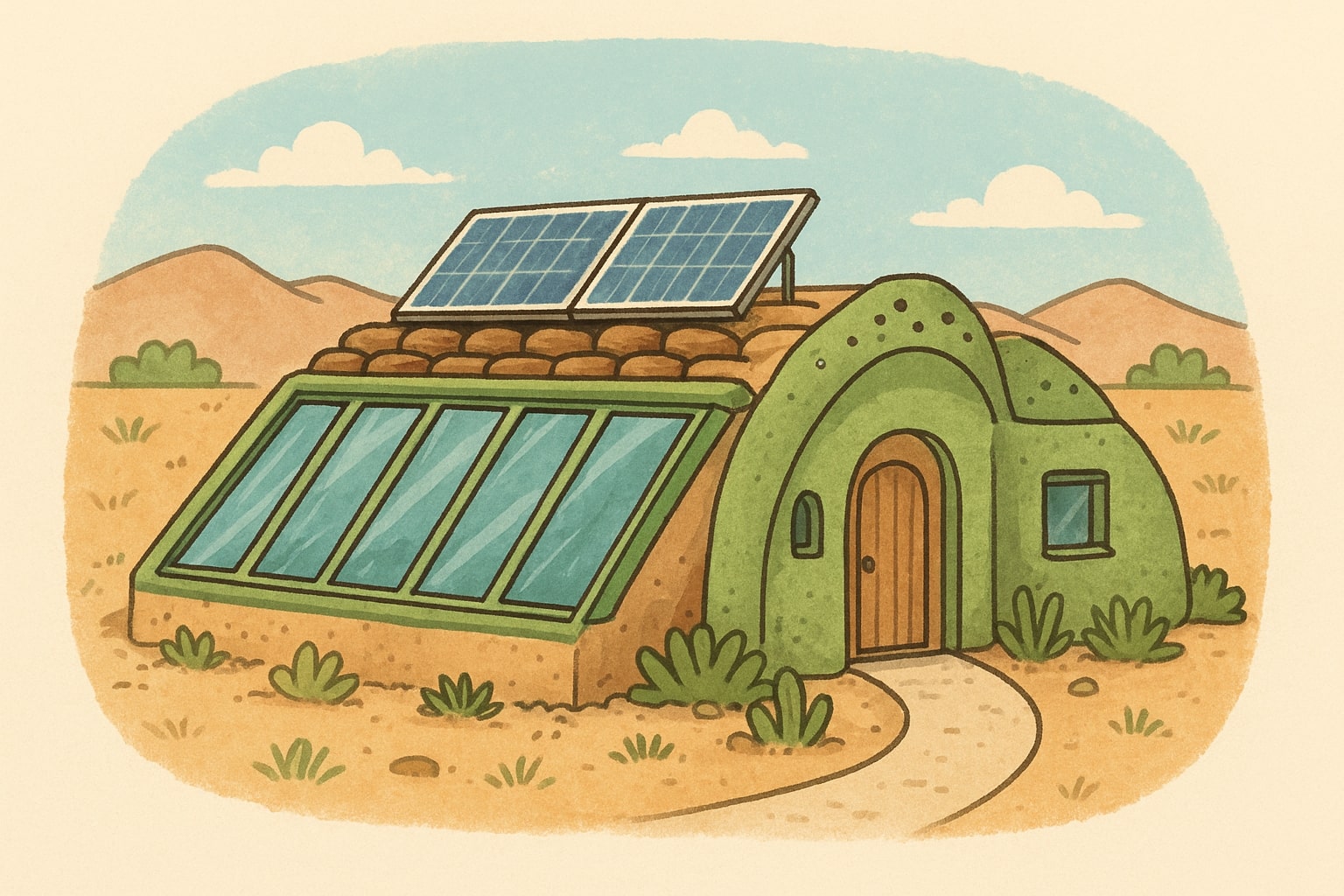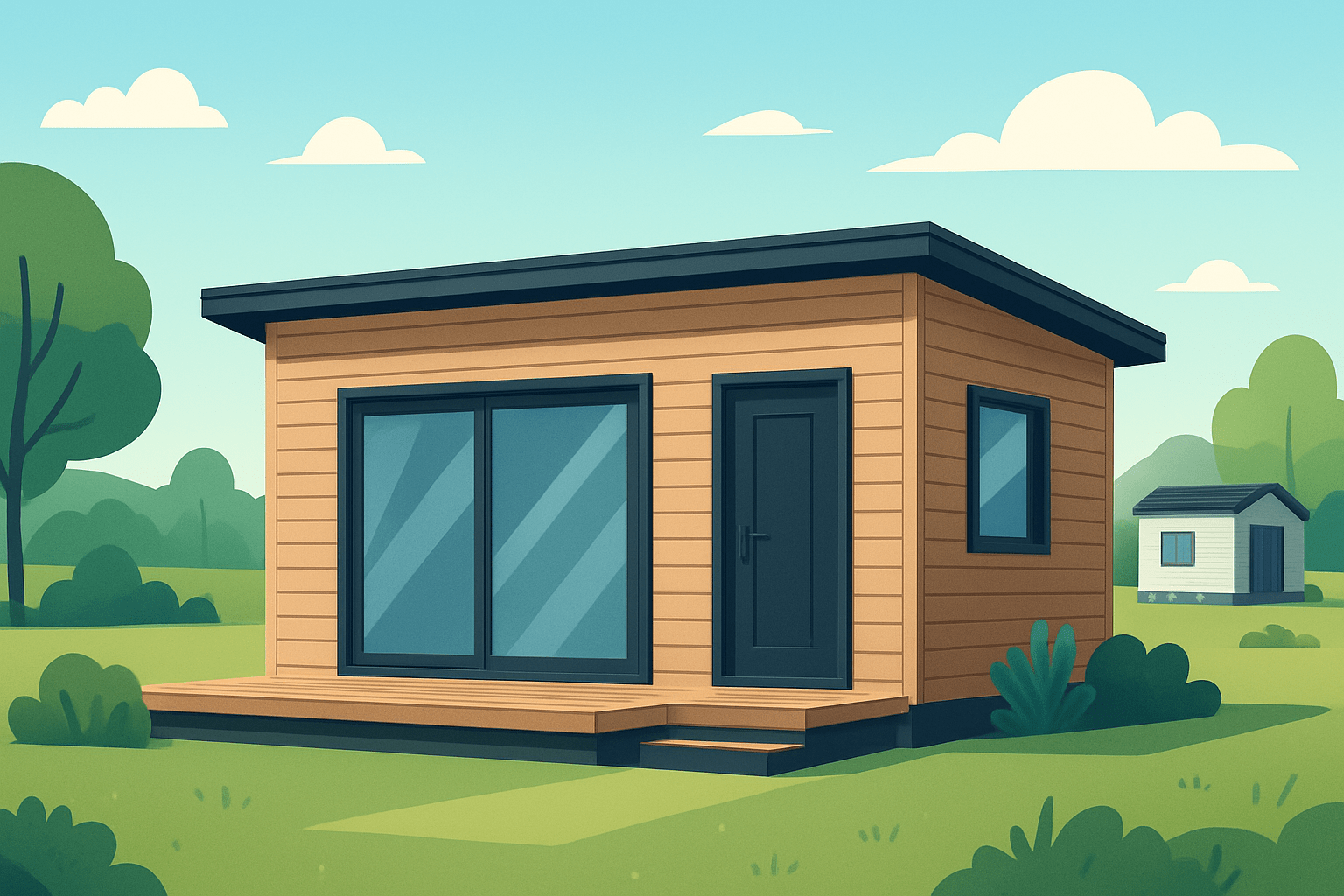Introduction 📜
I’ve always been fascinated by the idea of living in a home that powers itself, collects its own water, grows food, and uses recycled materials to do it all. When I first learned about Earthship homes, I realised they were much more than quirky eco-houses — they’re a full-scale blueprint for self-reliant, sustainable living. If you’ve ever dreamed of stepping off the grid, reducing your environmental impact, or simply understanding how an Earthship works, this guide will walk you through everything I’ve learned — from design principles and materials to real-world pros, cons, and costs.
1. What Exactly Is an Earthship Home?
An Earthship is a type of home designed to be as self-sufficient as possible. It generates its own energy, collects and reuses water, treats its own waste, and even produces food — all while being built from natural and recycled materials. The concept was developed by architect Michael Reynolds in the 1970s, in Taos, New Mexico. He wanted to create homes that could meet our basic needs — shelter, water, energy, and food — without depending on external systems or causing environmental harm. In simple terms, it’s a home that lives and breathes with the planet, rather than against it.
2. The Six Principles Every Earthship Follows
Earthship Biotecture, the organisation Reynolds founded, bases its designs on six key principles — all of which aim to help people live sustainably and independently:
- 🏗️ Use of natural and recycled materials – Old tires, cans, glass bottles, and reclaimed wood form the core of the structure.
- ☀️ Thermal and solar heating/cooling – Earthships use the sun and the thermal mass of the earth to regulate indoor temperature.
- ⚡ Solar and wind electricity – Renewable energy systems keep the lights on and the appliances running.
- 💧 Water harvesting – Roofs collect rainwater that’s filtered and reused throughout the home.
- 🧾 Contained sewage treatment – Greywater and blackwater are managed on-site through natural systems.
- 🌱 Food production – Indoor or attached greenhouses grow fruits, vegetables, and herbs year-round.
Together, these principles make an Earthship more than just a home — it’s a closed-loop ecosystem.
3. How an Earthship Works (and Why It’s So Clever)
1. Construction and Materials
The walls of an Earthship are usually made from earth-filled tires, stacked like giant bricks and covered with adobe or plaster. This gives the building incredible thermal mass — it stays warm in winter and cool in summer. I love that these homes reuse materials that would otherwise end up in landfills. Empty bottles and cans become decorative interior walls, creating colourful patterns when sunlight hits them. The north side of the home is typically bermed into the earth for insulation, while the south side faces the sun with large glass windows for natural heat and light.
2. Passive Solar Design
One of the most impressive parts of an Earthship is how it stays comfortable without mechanical heating or cooling. In winter, sunlight streams in through the south-facing windows, warming the walls and floor. That stored heat is slowly released at night. In summer, natural ventilation, shading, and the surrounding earth help keep temperatures stable.
3. Renewable Energy Systems
Solar panels (and sometimes small wind turbines) power the home. Batteries store energy, and an inverter converts it for daily use. I’ve seen some Earthships completely off-grid, and others that remain grid-connected just as backup. Either way, the goal is energy independence and minimal fossil fuel use.
4. Water Harvesting and Reuse
Water is collected from rainfall and snowmelt, stored in cisterns, and filtered for use inside the house. After it’s used for things like washing hands or dishes, it becomes greywater, which then irrigates the indoor garden. Even wastewater from toilets (blackwater) is treated through contained natural systems, usually planter beds that filter and reuse nutrients.
5. Food Production
Most Earthships have a built-in greenhouse — a lush, bright space that supports year-round growing. Some owners grow herbs and salad greens; others manage entire mini-gardens producing bananas, tomatoes, and citrus fruits. It’s amazing how much food you can grow in a controlled micro-climate right inside your home.
4. Why I Love the Earthship Concept
After studying sustainable architecture and visiting a few Earthships, I’ve realised how appealing they are — not just for the planet, but for people too. Here are some of the biggest advantages I’ve seen:
- 🌞 Energy freedom – Rely on the sun and wind instead of a utility company.
- 💧 Water independence – Collect and reuse rainwater rather than depend on a public supply.
- 🌱 Food resilience – Grow part of your own diet indoors, even in harsh climates.
- ♻️ Low environmental impact – Recycled materials, renewable systems, and zero-waste design.
- 🏡 Comfort and beauty – Naturally stable indoor temperature, plenty of light, and stunning hand-crafted details.
It’s the kind of home that feels alive — one that works with nature, not against it.
5. The Real-World Challenges
That said, building or buying an Earthship isn’t for everyone. There are challenges to be aware of:
- 🏛️ Building codes and permits – Many local authorities aren’t familiar with Earthships, so getting approval can be tricky.
- ⏳ Cost and time – While recycled materials are inexpensive, labour, systems, and custom design can add up.
- 🌦️ Climate limits – Designs need adapting for very wet, cold, or humid regions.
- 🔧 Maintenance – You’ll need to understand and manage your energy, water, and waste systems.
- 💰 Resale value – Because Earthships are unique, the buyer pool may be smaller than for conventional homes.
Still, for many of us who value independence and sustainability, those challenges are worth tackling.
6. Is an Earthship Right for Me?
When I think about whether an Earthship lifestyle fits, I ask myself questions like:
- 🌱 Am I excited about living more sustainably and taking responsibility for my resources?
- 🌞 Do I have (or can I find) land with good solar exposure and rainfall?
- ⏳ Can I commit the time, budget, and learning needed for off-grid systems?
If the answer is yes to most of those, an Earthship might be the perfect fit.
7. Visiting Earthships Around the World
If you want to see these homes in action, I highly recommend visiting one. The Earthship community near Taos, New Mexico is a great place to start — they offer tours, workshops, and even overnight stays. You can also find Earthships in places like the Netherlands, Australia, and the UK (Earthship Brighton) — each adapted beautifully to local climates and building codes.
8. My Favourite Resources and Further Reading
If you’re diving deeper into the world of sustainable architecture, these are some other articles I recommend (and that I’ll be linking to from this post):
- 🌞 Passive Solar Design: How Homes Use the Sun for Heating & Cooling
- 🧱 Thermal Mass in Building Design: Materials, Benefits & Best Practices
- 💧 Rainwater Harvesting Systems for Homes
- ⚡ Off-Grid Living: Pros, Cons & What You Should Know
- ♻️ Sustainable Building Materials You Can Use at Home
These topics all connect directly to the Earthship philosophy and help you understand how to apply its principles even in a conventional home.
Closing Thoughts
Living in an Earthship is about more than escaping the grid — it’s about reconnecting with the environment and taking control of your own basic needs. For me, the idea of a home that earns its keep — producing power, food, and water — feels deeply empowering. It’s a reminder that sustainable living isn’t just possible; it’s beautiful, practical, and incredibly rewarding. If you’ve ever dreamed of living closer to nature while maintaining comfort and creativity, an Earthship might just be your next adventure. 🌍


